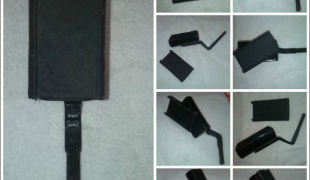- 9532
- 643
- 18
- 14
- 0
- Help Ukraine
About the solution
Because of a very high spinal cord injury, I'm almost completely paralyzed, can only move my head. When in my wheelchair, I can work with a head controlled computer in my living room. But I'm in bed most of the time: at night, during the care, and sometimes I have to stay in bed for days or even weeks. I need access to a computer 24/7, day ánd night. Big question was "how can I get computer access in bed while lying flat on my back??" There was no solution available (1997).
In the beginning, it was an almost impossible task, as a small monitor weight about 40Kg. Hanging that above your head would be dangerous. Everything computer back then was: large, heavy, noisy. But after some years, the first flat monitors came, and everything else computer was improving also. What I show on this page is my third head controlled bed computer, made in in 2016.
Above my bed-end, is the self-designed construction that holds a monitor and a head controlled computer. The only possible position I can be in for a sustained period of time, is laying on my back. There is just one position the computer monitor has to be in. I get in and out bed by mobile elevator. This is possible without hitting the monitor. But for just in case; the monitor can be pushed out of the way into an upright position.
The computer has to be a small and silent desktop computer. I'm a Mac user, so that reduces the options. I use a Mac mini, which is fine, though not very powerful. One other option of today would be the Mac Pro (beautiful, but expensive and old).
The screen resolution can not be very large, max 1920*1080 at 72dpi in my case, because I position the cursor by bumping the cursor against the borders, and the amount of movement of a neck is limited. Important is a screen technology that has dark blacks, for at night you want a dark screen. IPS is probably the best type at this (2016) moment.
What all is in the box? A lot!
- a small and silent desktop computer (Mac mini)
- a monitor (23 inch)
- an Origin HeadMouse
- computer speakers (include the amplifier)
- a microphone
- external harddisks
- usb hub
- IR controlled electricity socket
- a puff-to-click-switch, going to the HeadMouse or USB input device.
A puff-to-switch-tube must always be within reach of the mouth. I use a piece of hydraulic tube, the kind that is normally used in excavators and such. When bent in position, it stays in that position (until it wares out, which is after about 2 years).
You'll need an on-screen keyboard, as an ordinary keyboard is no option. The best one for Mac is: Keystrokes. Lately (2016) Apple has included an on-screenkeyboard in the system, but it lacks important options and comfort.
Making telephone calls? Over the internet with for example Skye, or use dialing software plus a USB modem, for example Dialectic and the USRobotics 56K USB modem. I use both, so if the internet is down, I can still make a call.
这些解决方案不应包括使用药物,化学品或生物制品(包括食品);创伤性设备;冒犯性的,商业或内在危险的内容。该解决方案未经医学验证。请谨慎进行!如果您有任何疑问,请咨询健康专家。
-
-
761
-
0
-
17013

Proloquo2Go – App to help people communicate
CAREGIVING
COMMUNICATION: Communicating, whether by speaking, listening, or other means
Social interaction
Paralysis
Autism
Cerebral Palsy
Brain Stroke
Brain Injury (Abscess, Brain Barrier Defect, Brain Contusion, Brain Hemorrhage, Brain Edema)
Assistive Daily Life Device (to help ADL)
Assistive Technology access
App (Including when connected with wearable)
Tremors
Muscle cramps or spasms
Difficulty coordinating movements
Muscle weakness
Difficulty speaking or understanding speech
Trouble with fine motor skills (e.g., writing, buttoning clothes)
Twitching or involuntary movements (myoclonus)
Acquired language impairment (Aphasia)
Promoting self-management
Managing Neurological Disorders
Building Supportive Community Relationships
Promoting inclusivity and social integration
Improving Speech and Communication
Caregiving Support
Clinical Pathology
Medical Genetics
Neurology
Pediatrics
Rheumatology
Netherlands
-
-
-
502
-
0
-
6943

Cell Phone Holder / Tablet / Iphone
Social interaction
COMMUNICATION: Communicating, whether by speaking, listening, or other means
Cerebral Palsy
Assistive Technology access
Strategy/Tip
Assistive Daily Life Device (to help ADL)
Gait abnormalities (e.g., walking difficulties, unsteady gait)
Difficulty coordinating movements
Stiffness or rigidity (difficulty moving)
Paralysis of the legs and lower body
Trouble with fine motor skills (e.g., writing, buttoning clothes)
Twitching or involuntary movements (myoclonus)
Acquired language impairment (Aphasia)
Promoting self-management
Managing Neurological Disorders
Promoting inclusivity and social integration
Raise awareness
Neurology
Portugal
-
-
-
570
-
0
-
9164

Eye controlled communication devices
COMMUNICATION: Communicating, whether by speaking, listening, or other means
CAREGIVING
Cerebral Palsy
Assistive Daily Life Device (to help ADL)
Assistive Technology access
Recovering cognitive function
Promoting self-management
Managing Neurological Disorders
Promoting inclusivity and social integration
Improving Speech and Communication
Neurology
Ophthalmology
Pediatrics
United States
-
 zh
zh